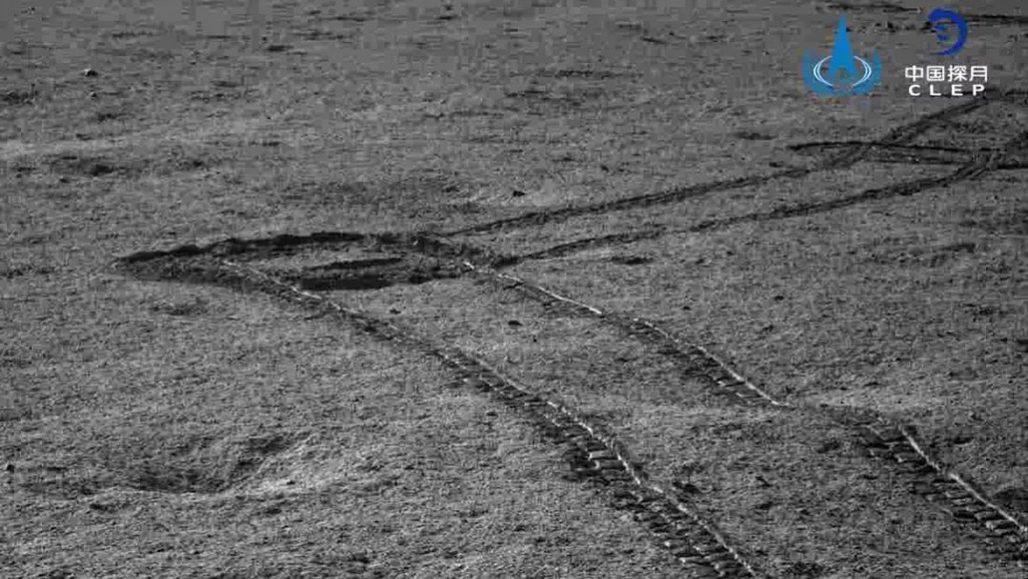Rover finds ‘layer cake’ below ground on moon’s farside
Radar on China’s Yutu-2 rover found ‘cake’ layers of fine sand and coarse gravel

China’s Yutu-2 rover left these tracks on the farside of the moon in 2019. This robot is using radar to probe the moon’s subsurface structure.
CNSA/CLEP
The farside of the moon is a lunar layer cake. That’s a new finding from China’s Chang’e-4 lander. The craft dispatched a lunar rover known as Yutu-2. And its laser revealed alternating layers of coarse rock and fine soil down to a depth of 40 meters (130 feet) beneath the rover’s wheels. This suggests a history of violent impacts.
Scientists shared the discovery on February 26 in Science Advances.
Lunar scientist Yan Su works for the Chinese Academy of Sciences in Beijing. “We know much of the moon’s nearside” from the Soviet Lunokhod and American Apollo programs, she says. In comparison, Su notes, details about the farside have been sparse. But the Chang’e-4 mission has started to change that. Su says it has “revealed the first ‘ground-truth’” about the farside’s below-ground structure.
Last year, Chang’e-4 became the first spacecraft to land on the farside. It touched down inside the Von Kármán crater, which spans 186 kilometers (116 miles). The Yutu-2 rover explored this crater, which lies within the South Pole–Aitken basin. The rover sent radar pulses into the ground within this crater, which is some 2,500 kilometers (1,550 miles) wide.
Lunar scientist Chunlai Li, also of the Chinese Academy of Sciences, was part of a team that analyzed the 106-meter (348-foot) path that the rover took while collecting data during its first two lunar days (about two Earth months). This team found a layer about 12 meters (39 feet) thick of fine soil — or regolith — closest to the soil surface.
“It’s like being on very clean sand,” says study coauthor Elena Pettinelli of Roma Tre University in Italy. Think of it, she says, “like you’re on the beach.”
Below that fine soil, the rover found another layer of about 12 meters containing coarser material embedded with larger rocks. The rocks were like cherries in a fruitcake. Lower still was a series of alternating layers of coarse and fine materials. They ran from about 24 meters (79 feet) down to roughly 40 meters (which was the limit of the rover’s radar).
What made those layers?
Those layers, the researchers say, were probably created by material ejected from the moon’s surface by successive impacts. By what? Meteorites. The floor of Von Kármán crater is a smooth sheet of cooled lava. (Long ago, the area had active volcanoes.) But over time, objects from space pummeled that lava over and over. The debris kicked up when objects like meteorites slam into the surface is known as ejecta. As it falls back to the ground, it can leave a fine layer of rocky bits atop any crater that the collision caused.
“That’s a really violent process,” says Daniel Moriarty. He’s a lunar geologist at NASA’s Goddard Space Flight Center in Greenbelt, Md. He did not take part in this study. Some of the ejecta could have come from as deep as the moon’s mantle, at least 60 kilometers (37 miles) below the surface!

Educators and Parents, Sign Up for The Cheat Sheet
Weekly updates to help you use Science News Explores in the learning environment
Thank you for signing up!
There was a problem signing you up.
The top layer of smooth sand is probably the result of the surface being pulverized by micrometeorites. Over time, extreme temperature shifts can further crack the rock into bits.
The view of the moon’s farside subsurface that Chang’e-4 sent back to Earth is different from that seen by an earlier Chinese rover. That Yutu rover landed in Mare Imbrium on the nearside of the moon in 2013. That rover’s radar was blocked by dense volcanic rock at a depth of just 10 meters (33 feet) or so. That’s probably because the nearside’s volcanic floodplains are closer to the surface than those on the farside.
“The subsurface structure at Chang’e-4’s landing site is more complex,” Su says. And that suggests it formed in a very different geological environment, she adds. In fact, the lava basement of the Von Kármán crater may be too deep for Yutu-2 to sense at all, his team suspects.
Future work could help figure out why the moon’s nearside is awash in smooth plains of volcanic rock — called mare (MAHR-ay) — while the farside is more rugged and cratered.
“One of the biggest driving questions in lunar science for a while has been, why does the nearside look so different from the farside?” Moriarty says. “If people can use what they found to unravel some of the volcanic history of the farside, that would be helpful.”







